 Welcome to the Computer Vision and Multimedia Lab website.
Welcome to the Computer Vision and Multimedia Lab website.
GET IN TOUCH
Tactile version of "Lucania '61" by Carlo Levi  / Versione tattile del telero "Lucania '61" di Carlo Levi
/ Versione tattile del telero "Lucania '61" di Carlo Levi 
Lucania ’61 is the large canvas (18.50 meters x 3.20 meters) that Carlo Levi painted to describe the Basilicata region and to honor the Lucan friend Rocco Scotellaro. It is kept in the Levi Room of the National Museum of Medieval and Modern Art in Matera. The artwork was commissioned by the Committee for the Celebrations of the Centenary of the Unity of Italy to represent Basilicata at the Italia 61 exhibition (Turin, May 1961). Aim of the project (2019) has been the realization of a tactile version that makes this artwork accessibile to visually impaired people. The 3D printed model has been presented to the public on the 19th of September 2024 by the Fondazione Giorgio Amendola - Associazione Lucana in Piemonte Carlo Levi, in Turin.
The haptic perception is made through contours and reliefs of key characters represented in the canvas. A legend is available for correspondence between the reliefs, labeled with Braille letters, and the characters.
The transition from 2D to tactile version is the thesis project of Roberto Nour for his Bachelor degree in Electronic and Computer Engineering (University of Pavia, a.y. 2018/2019), under the supervision of prof. Virginio Cantoni. The 3D model has been adapted for 3D printing by Massimiliano Pini. Advice from Nicola Stilla (Unione Italiana dei Ciechi e degli Ipovedenti - Consiglio Regionale Lombardo) and Giovanni Caserta. The first test 3D prints were made by Stefania Marconi (3D4MED). The final 3D print is done by the Fondazione Giorgio Amendola - Associazione Lucana in Piemonte Carlo Levi.

“Lucania ’61” by Carlo Levi, image from Il Telero di Carlo Levi da Torino un viaggio nella Questione Meridionale, Ed . Il Rinnovamento, 2015.

19 September 2024: presentation of the tactile version of Lucania '61. In photo, from left, Prospero Cerabona (president of the Fondazione Giorgio Amendola), Domenico Cerabona (director of the Fondazione Giorgio Amendola), Pino Mantovani (historian and art critic), Giovanni Caserta (online, professor and historian of Matera), Virginio Cantoni (professor emeritus of the University of Pavia) and Roberto Nour (graduated in Computer Engineering at the University of Pavia). In the middle photo, Prospero Cerabona shows the tactile version. In the right photo, Prospero Cerabona, Michela Favaro (deputy mayor of the city of Turin) and Domenico Cerabona in a frame of the video on the inauguration by "Events in Turin".
This artwork represents the life of the poet Rocco Scotellaro in three fundamental moments: in the center, adolescent Scotellaro; on the right, adult Scotellaro in Piazza Tricarico; on the left, Scotellaro lies deceased in a cave, surrounded by people afflicted by his loss. Scenes are inspired by Lucanian everyday life, some taken by Mario Carbone’s photos.
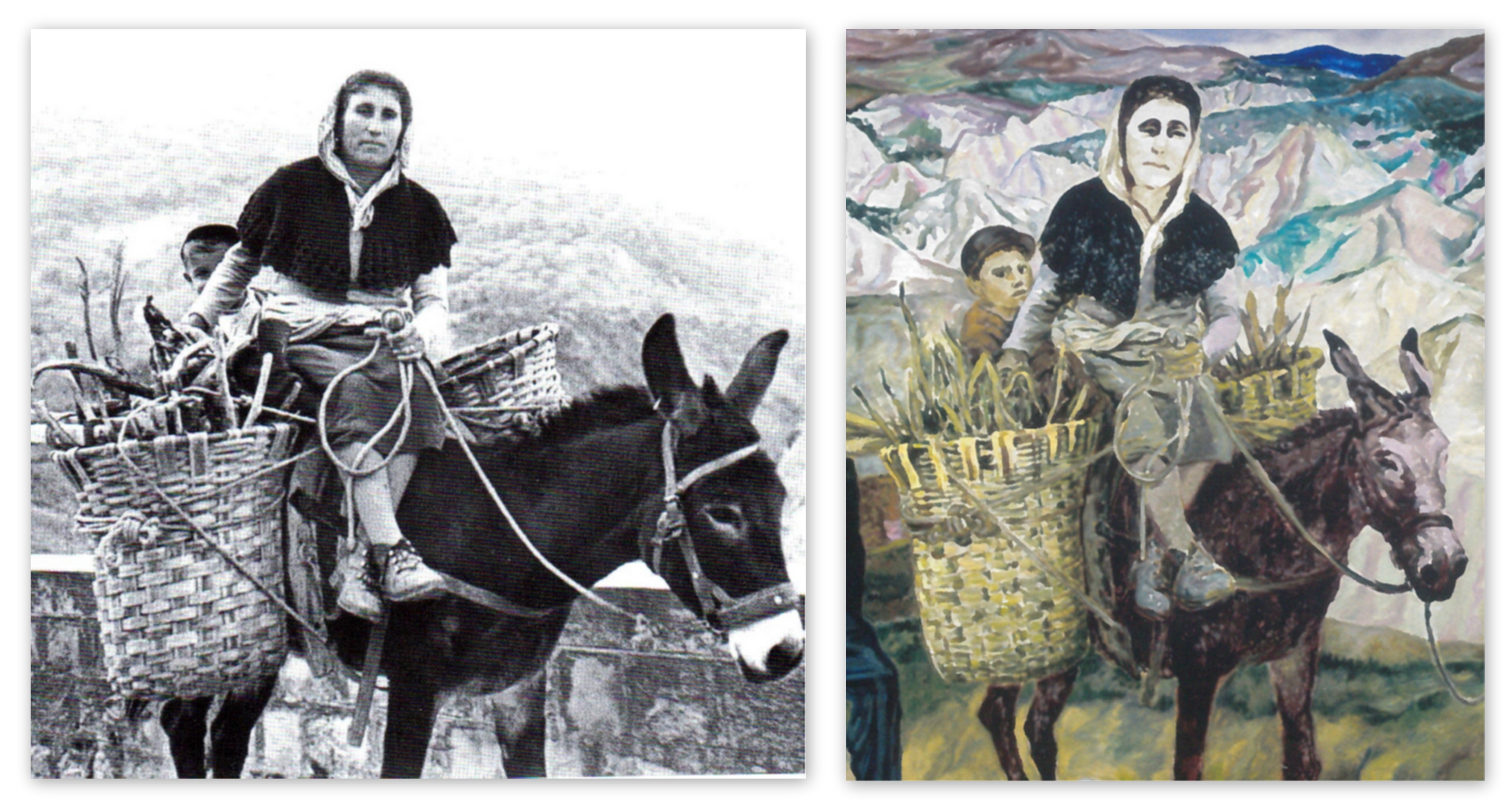
One of the photos taken by Mario Carbone and the corresponding scene painted by Carlo Levi.
Here are the followed steps:
1) Starting from an image of the original canvas, using a software for the elaboration of digital images, the contours of people, objects and landscapes have been extracted, applying a segmentation technique - DOG (Difference Of Gaussian) - that allows to highlight details of different sizes. So a specific layer has been created (Contours).
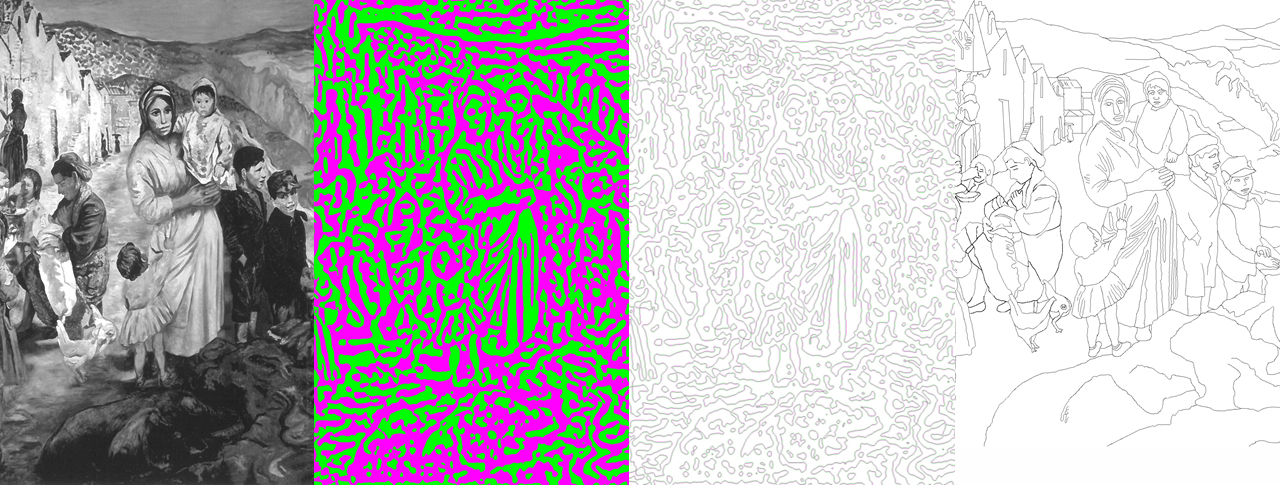
Extraction of contours of a part of the canvas.
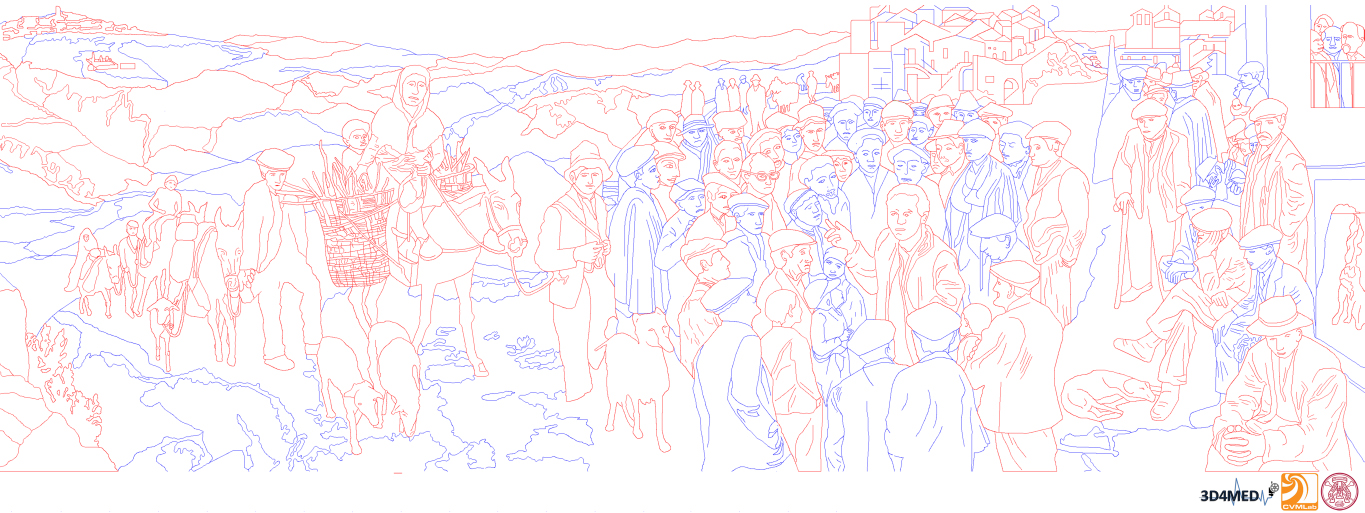
The contours of the right part of the canvas (different colours are associated to different levels).
2) The following phase has been the identification of characters/segments to be highlighted, filling their contour in green color (bucket tool of the image processing software); the remaining part has been left white, at a lowest level (Characters in relief).
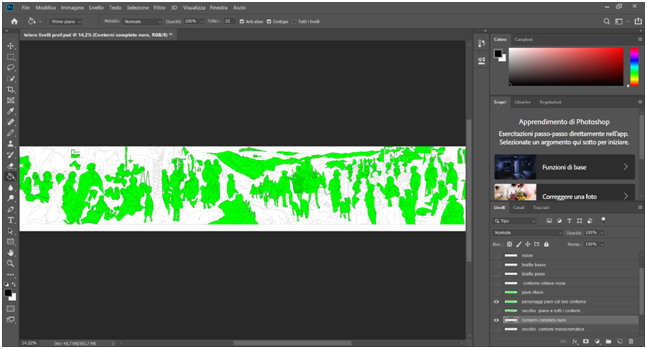
3) The relevant characters/segments have been labeled using Braille letters, in order to allow blind people to find a correspondence between an associated key-legend and the touched contour. The labels have been designed to be as intuitive as possible: each group of characters (politicians, men, women, children, animals, etc.) are identified with a group of Braille letters which generally have a common structural motif (Braille insertion).
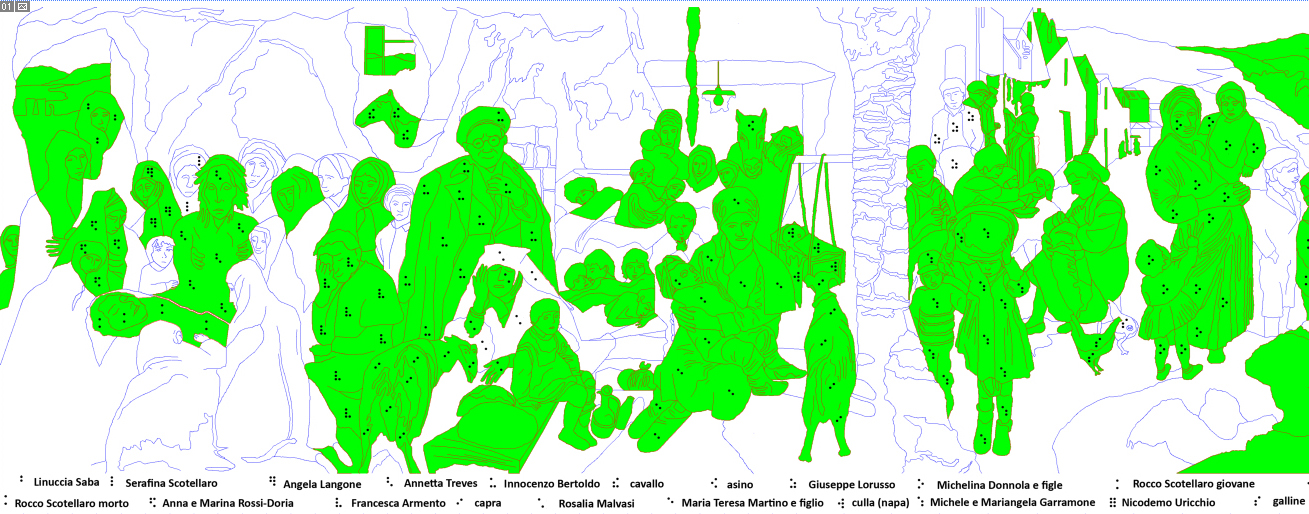
The left part (characters in relief - in green - and Braille letters).
4) After this step, the levels that will be differentiated in the printing phase have been created, so allowing haptic perception of what is depicted in the canvas:
- Level 0: background;
- Level 1: contours of empty characters and their Braille letters;
- Level 2: full characters and their Braille letters (Characters in relief with Braille);
- Level 3: contours of full characters.
5) A software for 3D modeling has been used to realize the structure for 3D printing.
6) The last step is to refine the 3D model for the specific 3D printer that will be used to produce the tactile version of the canvas.
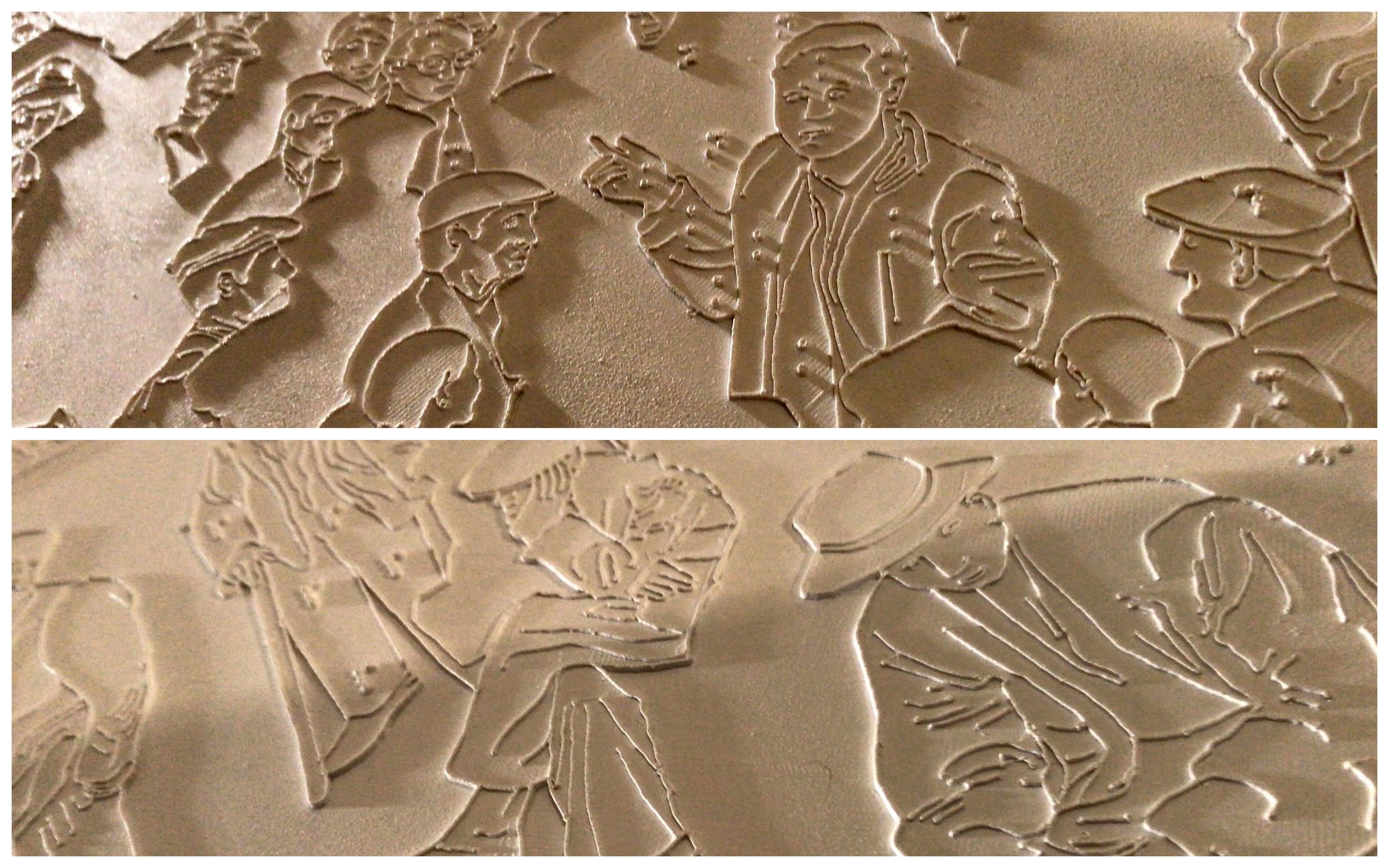
Two details of the 3D printed tactile version of Lucania '61 by Carlo Levi, presented on 19 September 2024 at the Fondazione Giorgio Amendola, in Turin.
Press review
Presentata la stampa 3D del modello tattile della tela “Lucania ’61”, da UNIPV.news - 27 settembre 2024
La Lucania dipinta da Levi riprodotta per i non vedenti, from La Stampa, Torino - 20/09/2024
Il Telero "Lucania '61" di Levi è accessibile ai non vedenti, from Cronaca Qui, Torino - 20/09/2024
Dipinto di Carlo Levi Lucania '61 ora per ciechi e ipovedenti, from ansa.it - 19/09/2024
Il Telero "Lucania '61" di Carlo Levi è ora fruibile anche per le persone cieche e ipovedenti. Alla Fondazione Amendola, from NonSoloContro, nonsolocontro.it - 19/09/2024
Il Telero “Lucania '61” diventa accessibile grazie alla Fondazione Giorgio Amendola, from TorinOggi.it - 19/09/ 2024
Inaugurazione mappatura 3D del Telero “Lucania '61” di Carlo Levi, video from Eventi a Torino - 19/09/2024
Un telero di Carlo Levi «mappato» in 3D, Notizie in breve, Giorno per giorno nell’arte, Notizia n. 12, from Il Giornale dell'Arte - 18/09/2024